Insert a column
How to insert a single column in a worksheet using Excel, VBA and Shortcut methods
| 1. Select an entire column where you want to insert a new column. Note: in this example we are inserting a new column as a second column (B). To select the entire column, either click on the column heading or select the first cell in the column, press and hold the Ctrl and Shift keys and press the Down key. |
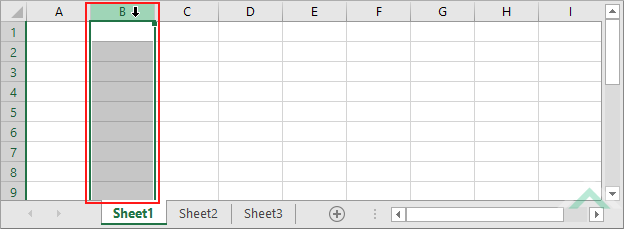 |
| 2. Right-click anywhere on the selected column and click Insert. | 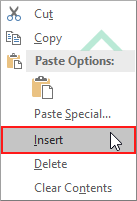 |
METHOD 2. Insert a column using the ribbon option
EXCEL
| 1. Select any cell in the same column where you want to insert a new column. Note: the new column will be inserted as column B, given we have selected a cell in the second column. |
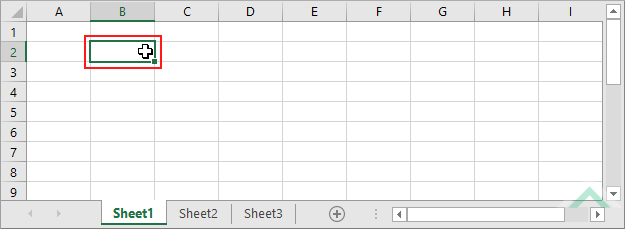 |
| 2. Select the Home tab. |  |
| 3. Click Insert in the Cells group. 4. Click Insert Sheet Columns. |
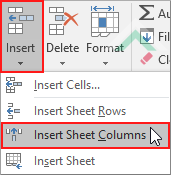 |
METHOD 3. Insert a column using the cell option
EXCEL
| 1. Right-click on any cell in the column where you want to insert a new column. 2. Click Insert Note: the new column will be inserted as column B, given we have right-clicked on a cell in the second column. |
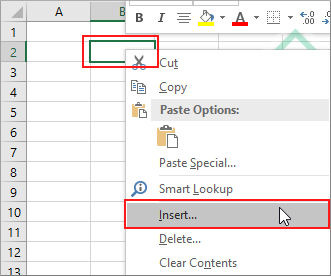 |
| 2. Select the Entire colomn option and click OK group. | 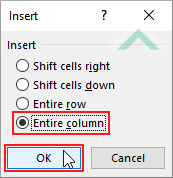 |
Worksheets("Sheet1").Range("B2").EntireColumn.Insert
End Sub
Worksheets: The Worksheets object represents all of the worksheets in a workbook, excluding chart sheets.
ADJUSTABLE PARAMETERS
Column Selection: Select where you want to insert a new column by changing the column reference ("B2"). You can also change the row reference to any row as this will have no impact on where the new column will be inserted.
Worksheet Selection: Select the worksheet where you want to insert a new column by changing the Sheet1 worksheet name.
Worksheets("Sheet1").Range("B2:B5").EntireColumn.Insert
End Sub
Worksheets: The Worksheets object represents all of the worksheets in a workbook, excluding chart sheets.
ADJUSTABLE PARAMETERS
Column Selection: Select where you want to insert a new column by changing the column reference ("B2:B5"). You can also change the row reference to any row as this will have no impact on where the new column will be inserted.
Worksheet Selection: Select the worksheet where you want to insert a new column by changing the Sheet1 worksheet name.
METHOD 3. Insert a column using VBA by selecting an entire column
VBA
Worksheets("Sheet1").Range("B:B").EntireColumn.Insert
End Sub
Worksheets: The Worksheets object represents all of the worksheets in a workbook, excluding chart sheets.
ADJUSTABLE PARAMETERS
Column Selection: Select where you want to insert a new column by changing the column reference ("B:B").
Worksheet Selection: Select the worksheet where you want to insert a new column by changing the Sheet1 worksheet name.
Method 1
Method 2
NOTES
The Plus Sign key in the first method refers to the key on the top of the keyboard. The Plus Sign key in the second method refers to the key to the right of the keyboard, which some devices will not have. The reason why the first method requires the use of the Shift key is because the Plus Sign key is used for both Plus and Equal Signs, therefore, to activate the Plus Sign you are required to use the Shift key.
This tutorial explains and provides step by step instructions on how to insert a single column in a worksheet using Excel, VBA and Shortcut methods.
Excel Methods: Using Excel you can insert a new column by selecting an entire column, a single cell or using a function from the ribbon.
VBA Methods: Using VBA you can insert a new column by referencing to a single cell, a range of cells or an entire column. If you want to insert a single column by referencing to a range of cells you need to ensure that the range of cells only references to a single column. As per the example in this tutorial the VBA code references to only column B across multiple rows ("B2:B5").
Shortcut Methods: Using a Shortcut you can instantly insert a new column by selecting the entire column where you want to insert a new column and actioning the shortcut.
ADDITIONAL NOTES
Note 1: Inserting a new column will move the existing columns, that are after the new column, rightwards. In this this tutorial every column after column B will be moved rightwards.
Note 2: If the last column has a cell that is not empty, you will not be able to insert a new column. To insert a single column you will need to ensure that every cell in the last column is clear of any content.
| Related Topic | Description | Related Topic and Description |
|---|---|---|
| Insert multiple columns | How to insert multiple columns in a worksheet using Excel, VBA and Shortcut methods | |
| Delete a column | How to delete a single column in a worksheet using Excel, VBA and Shortcut methods | |
| Delete multiple columns | How to delete multiple columns in a worksheet using Excel, VBA and Shortcut methods | |
| Insert a row | How to insert a single row in a worksheet using Excel, VBA and Shortcut methods | |
| Insert multiple rows | How to insert multiple rows in a worksheet using Excel, VBA and Shortcut methods |
